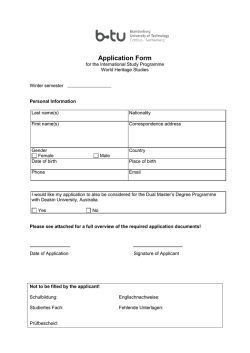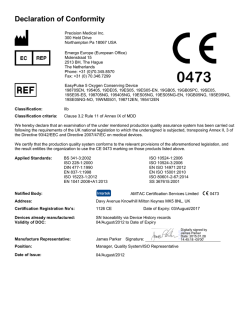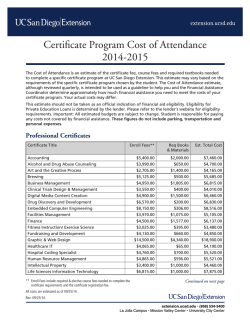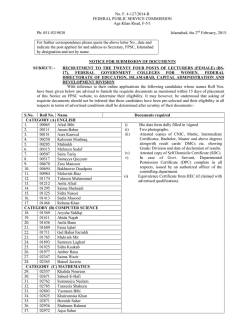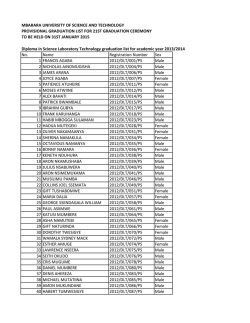
14/H227 - Weholite.co.uk
HAPAS APPROVAL INSPECTION TESTING CERTIFICATION Asset International Ltd Stephenson Street Newport Gwent NP19 4XH Tel: 01633 273081 Fax: 01633 290519 TECHNICAL APPROVALS FOR CONSTRUCTION HAPAS Certificate 14/H227 e-mail: [email protected] website: www.weholite.co.uk Product Sheet 1 WEHOLITE SURFACE WATER DRAINAGE SYSTEM WEHOLITE SURFACE WATER DRAINAGE PIPES This HAPAS Certificate Product Sheet (1) is issued by the British Board of Agrément (BBA), supported by the Highways Agency (HA) (acting on behalf of the Overseeing Organisations of the Department for Transport; Transport Scotland; the Welsh Assembly Government and the Department for Regional Development, Northern Ireland), the Association of Directors of Environment, Economy, Planning and Transport (ADEPT), the Local Government Technical Advisers’ Group and industry bodies. HAPAS Certificate Product Sheets are normally each subject to a review every three years. (1) Hereinafter referred to as ‘Certificate’. This Certificate relates to Weholite Surface Water Drainage Pipes comprising 450 mm to 900 mm internal diameter, structured wall, polyethylene pipes (perforated and unperforated), for use as filter and carrier pipes in highway drainage systems. The pipes are jointed on site by fusion welding. CERTIFICATION INCLUDES: • factors relating to compliance with HAPAS requirements • factors relating to compliance with Regulations where applicable • independently verified technical specification • assessment criteria and technical investigations • design considerations • installation guidance • regular surveillance of production • formal three-yearly review. KEY FACTORS ASSESSED Strength — the pipes have adequate strength to resist loads associated with installation and service (see section 6). Performance of joints — the pipes will remain watertight under normal service conditions (see section 7). Maintenance — the pipes may be cleansed using standard pipe cleaning techniques (see section 11). Durability — the pipes will have a service life in excess of 50 years (see section 12). The BBA has awarded this Certificate to the company named above for the products described herein. These products have been assessed by the BBA as being fit for their intended use provided they are installed, used and maintained as set out in this Certificate. On behalf of the British Board of Agrément Date of First issue: 28 November 2014 Brian Chamberlain Claire Curtis-Thomas Head of Approvals — Engineering Chief Executive The BBA is a UKAS accredited certification body — Number 113. The schedule of the current scope of accreditation for product certification is available in pdf format via the UKAS link on the BBA website at www.bbacerts.co.uk Readers are advised to check the validity and latest issue number of this Agrément Certificate by either referring to the BBA website or contacting the BBA direct. British Board of Agrément Bucknalls Lane Watford Herts WD25 9BA ©2014 Page 1 of 7 tel: 01923 665300 fax: 01923 665301 e-mail: [email protected] website: www.bbacerts.co.uk Requirements In the opinion of the BBA, Weholite Surface Water Drainage Pipes when used in accordance with the provisions of this Certificate, will meet or contribute to meeting the following requirements of the Manual of Contract Documents for Highways Works (MCHW)(1), Specification for Highways Works (SHW), Volume 1 and Volume 2. The general requirements for structured wall pipes and fittings are contained in the MCHW Volume 1, Clause 518. Further information and guidance is given in MCHW, Volume 3, Drawing Numbers F1 and F2. Additional site requirements may be included on particular contracts. (1) T he MCHW is operated by the Overseeing Organisations: The Highways Agency (HA), Transport Scotland, the Welsh Assembly Government and the Department for Regional Development (Northern Ireland). Regulations Construction (Design and Management) Regulations 2007 Construction (Design and Management) Regulations (Northern Ireland) 2007 Information in this Certificate may assist the client, CDM co-ordinator, designer and contractors to address their obligations under these Regulations. See sections: 1 Description (1.2), Delivery and site handling (3.4 and 3.5) and 12 Installation of this Certificate. Technical Specification 1 Description 1.1 Weholite Surface Water Drainage Pipes are manufactured from black, high density polyethylene to the material specification given Table 1. Table 1 Material properties/specification(1) Property Test method reference Specification BS EN ISO 527 22 MPa (50 mm·min–1) BS EN 728 >15 min (200°C) Melt mass-flow rate BS EN ISO 1133 0.3g·10 min–1 Density BS EN ISO 1183 956 kg·m–3 ISO 12091 — Tensile properties (stress at yield point) Thermal stability (OIT) Heat reversion (1) T his Table is in the format of Appendix 5/7 of MCHW, Volume 2. It is used to satisfy Clause 518.2 of MCHW, Volume 1. 1.2 The pipes are of structured-wall construction, with smooth inner and outer surfaces and are made from a spirally wound extruded box profile to the dimensions shown in Figure 1 and Table 2. The pipes are available in nominal internal diameters 450 mm, 600 mm, 750 mm and 900 mm. Figure 1 Details of pipe e5 profile height e4 profile width d1 Section through structured wall profile d2 Plan on pipe Page 2 of 7 Table 2 Pipe details(1) Internal pipe diameter d1 (mm) External pipe diameter d2 (mm) Profile height (mm) Profile width (mm) Minimum inner wall thickness e4 (mm) Minimum outer wall thickness e5 (mm) Nominal length (m) Minimum pipe weight per metre (kg·m–1) 450 506 28 35 2.3 1.9 6 13 600 675 38 47 3.2 2.6 6 22 750 838 44 55 4.1 3.3 6 34 900 1013 57 70 4.8 3.3 6 46 (1) Nominal values unless otherwise stated. 1.3 The pipes can be supplied either perforated or unperforated. Perforated pipes incorporate 10 mm diameter holes distributed in three rows 60° apart and may be placed at the crest or crown of the pipeline. The spacing of the holes and resultant permeable area per metre length of pipe are shown in Table 3. Table 3 Details of holes Internal pipe diameter (mm) Number of holes per metre run of pipe Nominal hole diameter (mm) Permeable area per metre run of pipe (mm2·m–1) 450 16 10 1256 600 15 10 1178 750 18 10 1413 900 21 10 1649 1.4 The pipes are designed to be joined by fusion welding on site (see section 15.1). 2 Manufacture 2.1 Weholite Surface Water Drainage Pipes are manufactured from black high density polyethylene. They are formed by spirally winding a preformed extruded box profile around a heated steel mandrel with adjacent sections welded together. The welded pipe is then reheated and trimmed to form a flat external surface. Where filter pipes are specified, 10 mm diameter drainage holes are drilled through the pipe walls at the required positions (see section 1.3). 2.2 As part of the assessment and ongoing surveillance of product quality, the BBA has: • agreed with the manufacturer the quality control procedures and product testing to be undertaken • assessed and agreed the quality control operated over batches of incoming materials • monitored the production process and verified that it is in accordance with the documented process • evaluated the process for management of nonconformities • checked that equipment has been properly tested and calibrated • undertaken to carry out the above measures on a regular basis through a surveillance process, to verify that the specifications and quality control operated by the manufacturer are being maintained. 2.3 The management system of Asset International Limited has been assessed and registered as meeting the requirements of BS EN ISO 9001 : 2008 and/or BS EN ISO 14001 : 2004 by BSI (Certificate FM12306). 3 Delivery and site handling 3.1 Weholite Surface Water Drainage Pipes are delivered to site in packs of between 9 and 30 pipes lengths depending on pipe diameter. A label bearing the BBA logo incorporating the number of this Certificate is attached to each pipe length or to each pack of pipes. 3.2 Handling, storage and transportation should be in accordance with MCHW and the Certificate holder’s instructions. 3.3 When long-term storage is envisaged, Weholite Surface Water Drainage Pipes must be protected from direct sunlight. If protection cannot be provided, consideration must be given to the effects of daily exposure to direct sunlight: • up to 3 months — negligible UV degradation but possible extreme surface temperatures of up to 80°C may cause some localised distortion • 3 to 12 months — may have significant effect on the impact resistance and physical properties • over 12 months — damage will occur unless protection is provided. 3.4 The pipes should be suitably supported at a minimum of two places when being lifted. Protected slings should preferably be used, but if metal hooks or chains are used then padding should be placed around the pipes. 3.5 The pipes should be stored on a flat surface, free from sharp projections, stones or other protuberances. They should not be stacked to a height of not more than 4 m high. 3.6 Care should be taken to avoid dropping the pipes on their ends, particularly during cold weather conditions. Page 3 of 7 Assessment and Technical Investigations The following is a summary of the assessment and technical investigations carried out on Weholite Surface Water Drainage Pipes. Design Considerations 4 General Weholite Surface Water Drainage Pipes comply with the requirements of the MCHW, Volume 1, Clause 518.5 for the pipes and Clause 518.7 for the system. When installed in accordance with the recommendations given in this Certificate, they are suitable for use in highways for the collection and disposal of surface and sub-surface water. 5 Practicability of installation The pipes should only be installed by contractors who have been trained and approved by the Certificate holder in accordance with the Certificate holder’s installation manual. 6 Strength 6.1 The pipes have a ring stiffness in excess of 6 kN·m–2 and a creep ratio of less than 4 and have adequate resistance to static loads. 6.2 The pipes have adequate resistance to impact loads to which they may be subjected during installation and in service. 6.3 The pipes can be used as an alternative to the plastic pipes for surface water drains listed in the MCHW, Volume 1, Table 5/1, and for safe bedding depth purposes may be assumed to have a standard dimension ratio (SDR) equivalent of not greater than 41. 7 Performance of joints Correctly made, the welded joints remain watertight. 8 Water infiltration The perforated area for the infiltration pipes exceeds the HA minimum requirement given in the MCHW, Volume 1, Clause 518.3 of 1000 mm2 per metre length (see section 1.3) of this Certificate. 9 Flow characteristics 9.1 The pipes will have normal flow characteristics associated with thermoplastic pipes. 9.2 Full-bore velocities are available from the Tables for the hydraulic design of pipes, sewers and channels, Volume 2, 8th Edition by H R Wallingford and D I H Barr. The values are based on the Colebrook-White equation. An appropriate value of roughness coefficient should be selected when designing the drainage system. For new pipes, a value of 0.006 mm is applicable, but for design purposes, a value of 0.6 mm is generally used. 10 Resistance of chemicals The pipe will be unaffected by those types and quantities of chemicals likely to be found in surface water. 11 Maintenance 11.1 Access to the system for cleaning should be provided by conventional methods, eg manholes, inspection chambers and rodding access points. 11.2 In common with other standard plastic drainage systems, toothed root cutters and rods with metal ferrules, as used with some mechanical clearing systems, could damage the pipes and couplers and should not be used. 11.3 The pipes can be cleansed using low pressure, high volume jetting equipment in accordance with the MCHW, Volume 1, Clause 520. 12 Durability In the opinion of the BBA, when used in the context of this Certificate, the material from which the pipes are manufactured will not significantly deteriorate and the anticipated life of the system will be in excess of 50 years. 13 Reuse and recyclability The pipes are manufactured from polyethylene and can be recycled. Page 4 of 7 Installation 14 General 14.1 Weholite Surface Water Drainage Pipes must be installed in accordance with HA requirements and the MCHW, Volume 1, Clauses 503, 505, 518.7 and 518.8. 14.2 The pipes are installed using traditional drain-laying methods. The pipes can be handled and installed readily in the lengths as supplied. 14.3 The pipes must be protected from damage from site construction traffic. 15 Procedure 15.1 The pipes must be prepared and fusion welded by trained operatives in accordance with the Certificate holder’s documented procedures. 15.2 The pipe can be cut using conventional hand tools and should be cut square. 15.3 The pipe edge to be welded should be chamfered using an abrasive disc and the oxide layer removed. 15.4 The pipes should be raised on timbers, butted together leaving a gap of between 10 mm and 20 mm and tack welded. Note: Hand-held extruders should be allowed to warm up for between 20 and 30 minutes prior to use, dependent on ambient temperature. 15.5 The tack welds should be allowed to set and the oxide layer removed with an abrasive disc. 15.6 Root weld should be laid around the joint with an angled weld tip. The oxide layer should be removed with an abrasive disc when the weld has set. The joint should be capped using a ‘half-moon’ shaped head attachment. Note: In sub-zero temperatures and rain, joints should be tented off. 15.7 Joints can be welded either in the trench, depending on the depth of dig and relevant Health and Safety Regulations, or above the trench and lifted into place after welding. 15.8 Proper equipment should be used when lifting a welded string of pipes and the pipeline should be slung so as to avoid excessive strain on the welded joints. 15.9 Care should be taken during backfill to maintain the line and level of the pipelines. If necessary, the pipe should be restrained to prevent uplift. 15.10 For typical laying, trench and backfilling specification details reference should be made to Figure 2 of this Certificate and the MCHW, Volume 3, Drawing Numbers F1 (Type T and S) and F2 (Type G, H and I). Figure 2 Trench and bedding details carrier drains filter drains X /6 type S KEY 100 min X /6 type I 100 min X type H 75 75 X /3 X X 75 type G 50 X 300 50 X + 600 max X + 300 min X 50 X/2 Y 300 Y Y X + 600 max X + 300 min type T KEY Type A or C filter material to S.H.W. Clause 505 or granular material to S.H.W. Clause 503.3(i) Granular material to S.H.W. Clause 503.3(i) Type B filter material to S.H.W. Clause 505 Material to S.H.W. Clause 503.3(ii), eg sand Class 8 material to S.H.W. Clause 503.3(iv) Mix ST2 concrete Notes: (1) All dimensions are in millimetres (2) Dimension X is the external diameter of the pipe (3) Dimension Y is either X + 300 mm for drains not exceeding 1.5 m cover below finished level or X + 450 mm for drains exceeding 1.5 m cover below finished level Page 5 of 7 Technical Investigations The following is a summary of the technical investigations carried out on the Weholite Surface Water Drainage System. 16 Tests 16.1 The following tests were carried out to determine the characteristics of the pipe and the pipe material: • impact test to MCHW, Clause 518 requirements at temperatures 0°C and 23°C • pipe stiffness to BS EN ISO 9969 : 1995 • creep ratio to BS EN ISO 9967 : 1995 • tensile properties to BS EN ISO 527-1 : 1996 and BS EN ISO 527-2 : 1996 • oxygen induction to BS EN 728 : 1997 • melt flow rate to BS EN ISO 1133 : 2000 • density to BS EN ISO 1183-3 : 1999 • heat reversion to ISO 12091 : 1995 • ring flexibility to BS EN 1446 : 1996 • internal puncture to MCHW, Clause 518 • tensile strength of seam to MCHW, Clause 518. 16.2 Tests were carried out to establish the dimensional accuracy of the pipe. 17 Investigations 17.1 An examination was made of data in relation to the effect of the production tolerances on the performance of the products. 17.2 An evaluation of existing data was made to assess material properties, chemical resistance and durability. 17.3 Calculations were carried out to determine the slot area. 17.4 The manufacturing process was evaluated, including the methods adopted for quality control, and details were obtained of the quality and composition of the materials used. Bibliography BS EN 728 : 1997 Plastics piping and ducting systems — Polyolefin pipes and fittings — Determination of oxidation induction time BS EN 1446 : 1996 Plastic piping and ducting systems — Thermoplastic pipes — Determination of ring flexibility BS EN ISO 527-1 : 1996 Plastics — Determination of tensile properties — General principles BS EN ISO 527-2 : 1996 Plastics — Determination of tensile properties — Test conditions for moulding and extrusion plastics BS EN ISO 9001 : 2008 Quality management systems BS EN ISO 9967 : 1995 Thermoplastic pipes — Determination of creep ratio BS EN ISO 9969 : 1995 Thermoplastic pipes— Determination of ring stiffness BS EN ISO 14001 : 2004 Environmental management systems — Requirements with guidance for use BS EN ISO 1133 : 2000 Plastics — Determination of the melt mass-flow rate (MFR) and the melt volume-flow rate (MVR) of thermoplastics BS EN ISO 1183-3 : 1999 Plastics — Methods for determining the density and relative density of non-cellular plastics ISO 12091 : 1995 Structural wall thermoplastics pipes — Oven test Manual of Contract Documents for Highway Works, Volume 1 Specification for Highway Works Manual of Contract Documents for Highway Works, Volume 2 Notes for Guidance on the Specification for Highway Works Manual of Contract Documents for Highway Works, Volume 3 Highway Construction Details Page 6 of 7 Conditions of Certification 18 Conditions 18.1 This Certificate: • relates only to the product/system that is named and described on the front page • is issued only to the company, firm, organisation or person named on the front page — no other company, firm, organisation or person may hold or claim that this Certificate has been issued to them • is valid only within the UK • has to be read, considered and used as a whole document — it may be misleading and will be incomplete to be selective • is copyright of the BBA • is subject to English Law. 18.2 Publications, documents, specifications, legislation, regulations, standards and the like referenced in this Certificate are those that were current and/or deemed relevant by the BBA at the date of issue or reissue of this Certificate. 18.3 This Certificate will remain valid for an unlimited period provided that the product/system and its manufacture and/or fabrication, including all related and relevant parts and processes thereof: • are maintained at or above the levels which have been assessed and found to be satisfactory by the BBA • continue to be checked as and when deemed appropriate by the BBA under arrangements that it will determine • are reviewed by the BBA as and when it considers appropriate. 18.4 The BBA has used due skill, care and diligence in preparing this Certificate, but no warranty is provided. 18.5 In issuing this Certificate, the BBA is not responsible and is excluded from any liability to any company, firm, organisation or person, for any matters arising directly or indirectly from: • the presence or absence of any patent, intellectual property or similar rights subsisting in the product/system or any other product/system • the right of the Certificate holder to manufacture, supply, install, maintain or market the product/system • actual installations of the product/system, including their nature, design, methods, performance, workmanship and maintenance • any works and constructions in which the product/system is installed, including their nature, design, methods, performance, workmanship and maintenance • any loss or damage, including personal injury, howsoever caused by the product/system, including its manufacture, supply, installation, use, maintenance and removal • any claims by the manufacturer relating to CE marking. 18.6 Any information relating to the manufacture, supply, installation, use, maintenance and removal of this product/ system which is contained or referred to in this Certificate is the minimum required to be met when the product/system is manufactured, supplied, installed, used, maintained and removed. It does not purport in any way to restate the requirements of the Health and Safety at Work etc. Act 1974, or of any other statutory, common law or other duty which may exist at the date of issue or reissue of this Certificate; nor is conformity with such information to be taken as satisfying the requirements of the 1974 Act or of any statutory, common law or other duty of care. British Board of Agrément Bucknalls Lane Watford Herts WD25 9BA ©2014 Page 7 of 7 tel: 01923 665300 fax: 01923 665301 e-mail: [email protected] website: www.bbacerts.co.uk
© Copyright 2024
